With its new Scrambler 900, Triumph has taken its longest look in the rearview mirror since the arrival of its born-again Bonneville in 2000. For those lacking enough gray hair to know better, the new Scrambler is a modern tribute to one of the most fondly remembered models of the '60s--the go-anywhere TR6C.
Despite being sold only in the U.S., the TR6C is for many enthusiasts Triumph's most alluring model ever, its rakish stance, high pipes and pullback, high-rise handlebar looking cool and purposeful even today. With its two-tone paint, twin high-mount exhausts, 19-inch front wheel and knobby tires, the stripped-down street scrambler said James Dean, the Sunset Strip, Ray-Bans and the Beach Boys with every turn of its wheels. The fact it was a true go-anywhere bike ideally tailored for unpaved or poorly surfaced roads made the TR6C a fearsome '60s racer that dominated American off-road events such as the Catalina Grand Prix and the grueling Big Bear Run, which it won four years in a row. All this gave the bike added credibility, and helped explain why by '67 Triumph's Meriden factory couldn't keep up with trans-Atlantic demand either in quantity or quality, a key factor in its demise just five years later.
The Scrambler--the reinvention of the TR6C--is the last Triumph styled by famed designer John Mockett, the man responsible for a slew of Hinckley's hits including the Rocket III, Speed Triple, Tiger, T595 Daytona, Bonneville and Bonneville America--plus the aborted four-cylinder 1300cc ultrasport. Still, Mockett insists all he did was follow the design cues of the company's '60s stylists.
"The TR6C had such a strong identity, it was simply a case of producing something similar in a modern context using the same key features," he says. "The biggest problem was packaging the exhausts--I'm glad we managed to keep the crossover headers, but we had to swap sides with the stacked pipes because the battery box got in the way for running them on the left. It's pleasing to see they've kept just about everything else from my original prototype."
In this case, everything else means items such as the rubber fork gaiters, twin chromed shocks (with a bit more travel), the small headlight topped only by a round speedo, the spacious but flat dual seat with cream piping, the high handlebar (pulled back just enough to deliver upright, comfortable ergos), the 4.4-gallon two-tone fuel tank (available in blue/white or red/white) and chromed spoke wheels, a skinny 19 x 2.5-incher up front matched to a 17 x 3.5-inch rear, both shod with reasonably chunky Bridgestone rubber. All these and numerous other detail touches denote a bike that is, visually at least, an entirely accurate trip down memory lane for those old enough to remember.
The two weeks I spent riding the Scrambler around the Warwickshire country lanes--where as a kid I used to encounter Triumph test-rider Percy Tait roaring past me on a succession of factory prototypes, including the original TR6C--underlined how visually successful this new bike is. Just looking at it as I opened my garage door after scraping away the ice gave me a warm SoCal feeling. Judging by the admiration the bike fielded from fans of all ages, this is a motorcycle with a genuine presence.
Obviously, the Scrambler puts convenience and cool ahead of actual performance. Just as well, then, because Triumph gave the Scrambler the weakest of its three Bonneville-spec twins--the 270-degree 865cc engine from its Speedmaster cruiser. Despite having more displacement than the standard Bonnie's 360-degree 790cc air/oil-cooled vertical-twin, the Speedmaster engine--more of a low-revving torquer--actually makes less horsepower (55 bhp) than the base engine's 61. It makes slightly more torque, but that's still a relatively stingy output for a bike that weighs 452 pounds dry. This is especially true when you consider the TR6C's pushrod motor gave 45 bhp 30 years ago in a lighter, 364-pound package.
If a Scrambler owner plans mostly misty-eyed trips down memory lane, along with an occasional hard-packed fire-road, the bike's output will be sufficient. But to anyone looking for even slightly more performance than this, the Scrambler could likely seem underpowered, with no trace of the rorty performance its predecessor delivered. And don't think this dearth of power is because the Scrambler constitutes Triumph's twin-cylinder entry into the off-road arena. It's not, as my occasional off-road forays proved. Although reasonably happy on smooth gravel or dirt roads, its off-road performance is limted by the relatively short-travel suspension and the tires, which are easily defeated by mud and loose sand.
The Scrambler starts easily even in cold weather thanks to a carb-mounted choke, and while controls are light and easy to use (especially the clutch), the shift lever's throw is inordinantly long. Once on the road I immediately noticed several things. The brakes--a single 310mm disc up front and a 255mm unit in back--could be better, the front a bit more powerful and the rear less grabby. The bike's sound is flat and uninspiring, not at all what you expect if you know anything about '60s-spec Triumphs. And those chunky tires, as poor as they are in mud and sand, are also fairly noisy (and vibratory) on the tarmac.
None of this matters much in the Scrambler's natural habitat: city streets, especially traffic-clogged ones, where you can use its easy clutch action, responsive throttle and light, immediate steering to plot an ideal course through rush-hour traffic, helped along by a tall and comfortable saddle. Then, as a brief stretch opens up, the Scrambler's decent low-end power can overcome its humble peak power and let you gear-up and go without feeling you have to gas it like Sete Gibernau. Problem is, the bike runs out of breath too early as revs and speeds mount. With just a bit more midrange to let you accelerate smartly away from 50 mph, it'd be an ideal tool for the Paris Peripherique or the San Diego Freeway at 4 p.m. on a Friday afternoon. Speeds of 65 to 70 mph are the Scrambler's optimum cruising velocities. It'll crack 100 if you hold on tight, but most owners will prefer to just go with the flow till they come to a snarl-up, then use the bike's agility to sneak through traffic. This should be a favored courier bike as well as an ideal ride-to-work tool, especially at the reasonable $7999 retail price.
But what about performance-loving customers? Aftermarket exhaust pipes will only do so much. A rephased crankshaft will cost a lot more, though an engine from a Thruxton or Bonneville insurance write-off would be tempting. Triumph's own aftermarket catalog for the Scrambler seems more concerned with looks than performance, with a tach, sump guard, flyscreen, competition number plates, a single-seat conversion with luggage rack and a range of Swinging Sixties SoCal clothing.
What's wrong is that Triumph hasn't read its history books well enough. Just as its Meriden-based predecessors realized 30 years ago, two distinct TR6C street scrambler products were needed for their diverse American customers. The new-generation Scrambler is that classic English compromise: It has the potential to please, but falls between two stools trying to cover both sides of the bar--and ends up satisfying few.
What's needed is a street-focused version with proper street tires and the more powerful 360-degree Thruxton engine--or at least the 61-bhp Bonnie engine--and pretty much everything else untouched. This would please the Scrambler's largest target audience and would be a lot more enjoyable to ride. Then, if the mass of the Bonnie engine isn't too large a problem, Triumph might try a more dedicated retro trailbike that's gone on a diet, with proper off-road tires, the same low level of tune (but a 360-degree motor) and slight single-seater restyling incorporating the luggage rack as standard.
But let's leave the last word to Mockett: "For whatever reason, I shan't be doing any more work for Triumph, so I reckon this is a good one to bow out on," he says. "I'm biased, of course--but I reckon it's got The Look, and they've kept my original concept pretty faithfully.
"Anyway, I don't know why you blokes always want more power. We'll soon all be legislated into non-existence as bikers, so we won't be able to ride anywhere without a man walking with a red flag in front of us, just like a century ago when motorcycles got started."
Let's hope he's wrong on this one. -MC
2006 TRIUMPH SCRAMBLER
PRICE
MSRP: $7999
ENGINE
Type: a-c vertical-twin
Valve arrangement: dohc, 8v
Displacement: 865cc
Transmission: 6-speed
CHASSIS
Weight: 452 lb. dry (205kg)
Fuel capacity: 4.4 gal. (17L)
Wheelbase: 58.3 in. (1480mm)
Seat height: 32.5 in. (825mm)










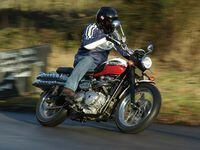
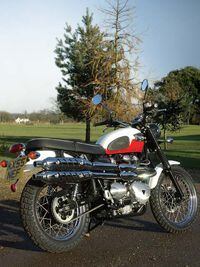

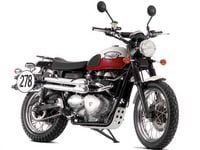
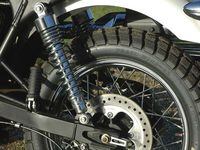

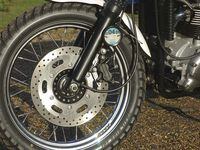
/cloudfront-us-east-1.images.arcpublishing.com/octane/QCZEPHQAMRHZPLHTDJBIJVWL3M.jpg)
/cloudfront-us-east-1.images.arcpublishing.com/octane/HXOUJXQWA5HBHGRO3EMJIGFMVI.jpg)

/cloudfront-us-east-1.images.arcpublishing.com/octane/3TIWWRV4JBBOLDVGRYECVVTA7Y.jpg)
/cloudfront-us-east-1.images.arcpublishing.com/octane/KIX5O23D5NAIBGFXBN3327DKZU.jpg)
/cloudfront-us-east-1.images.arcpublishing.com/octane/7GJYDUIPXRGMTMQKN6ONYOLBOU.jpg)
/cloudfront-us-east-1.images.arcpublishing.com/octane/MUQLOVLL2ZDGFH25ILABNBXKTI.jpg)
/cloudfront-us-east-1.images.arcpublishing.com/octane/TNOU5DNE2BC57MFPMGN2EIDXAM.jpg)
/cloudfront-us-east-1.images.arcpublishing.com/octane/GTCXACQGJ5HAPDTGWUQKDEH44E.jpg)
/cloudfront-us-east-1.images.arcpublishing.com/octane/S35YGSEMEZB4BLTDJTSZPF4GLA.jpg)
/cloudfront-us-east-1.images.arcpublishing.com/octane/5UOT6HPX2JFMRJAX6EH45AR4MQ.jpg)
/cloudfront-us-east-1.images.arcpublishing.com/octane/OKWOJWAKP5EP3OACCRRWPCIX2Q.jpg)
/cloudfront-us-east-1.images.arcpublishing.com/octane/2WF3SCE3NFBQXLDNJM7KMXA45E.jpg)
/cloudfront-us-east-1.images.arcpublishing.com/octane/G4MG6OUCJNBSHIS2MVVOTPX65E.jpg)
/cloudfront-us-east-1.images.arcpublishing.com/octane/IIGGWFOTOJGB7DB6DGBXCCMTDY.jpg)
/cloudfront-us-east-1.images.arcpublishing.com/octane/QSTCM6AVEZA5JJBUXNIQ3DSOF4.jpg)
/cloudfront-us-east-1.images.arcpublishing.com/octane/U4I7G625B5DMLF2DVIJDFZVV6M.jpg)
/cloudfront-us-east-1.images.arcpublishing.com/octane/B6XD6LS6IVCQPIU6HXDJSM3FHY.jpg)
/cloudfront-us-east-1.images.arcpublishing.com/octane/ICL63FEDDRDTTMINYICCEYGMDA.jpg)
/cloudfront-us-east-1.images.arcpublishing.com/octane/FCGZHQXRBZFLBAPC5SDIQLVF4I.jpg)
/cloudfront-us-east-1.images.arcpublishing.com/octane/WNOB6LDOIFFHJKPSVIWDYUGOPM.jpg)

/cloudfront-us-east-1.images.arcpublishing.com/octane/X33NU3E525ECRHXLNUJN2FTRKI.jpg)
/cloudfront-us-east-1.images.arcpublishing.com/octane/6KKT5NNL2JAVBOXMZYS5ZO76YA.jpg)